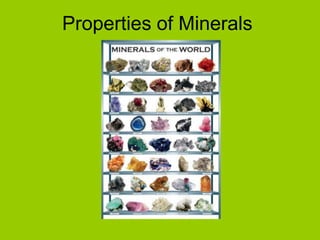Report
Share

Recommended
More Related Content
What's hot
What's hot (20)
Minerals / Common Rock-forming Minerals and their Physical and Chemical Prope...

Minerals / Common Rock-forming Minerals and their Physical and Chemical Prope...
Viewers also liked
Viewers also liked (20)
Earth Science 1.3 : Formation, Mining, and use of Minerals.

Earth Science 1.3 : Formation, Mining, and use of Minerals.
Types of Minerals, Earth Science Lesson PowerPoint

Types of Minerals, Earth Science Lesson PowerPoint
Distribution of mineral resources in india[www.jobsnstudyportal.in]![Distribution of mineral resources in india[www.jobsnstudyportal.in]](data:image/gif;base64,R0lGODlhAQABAIAAAAAAAP///yH5BAEAAAAALAAAAAABAAEAAAIBRAA7)
![Distribution of mineral resources in india[www.jobsnstudyportal.in]](data:image/gif;base64,R0lGODlhAQABAIAAAAAAAP///yH5BAEAAAAALAAAAAABAAEAAAIBRAA7)
Distribution of mineral resources in india[www.jobsnstudyportal.in]
Physical Geography Lecture 12 - Plate Tectonics 111616

Physical Geography Lecture 12 - Plate Tectonics 111616
Physical Geography Lecture 14 - Folding, Faulting, and Earthquakes 112816

Physical Geography Lecture 14 - Folding, Faulting, and Earthquakes 112816
Similar to Properties of minerals
Similar to Properties of minerals (20)
More from stetson100
More from stetson100 (11)
Properties of minerals
- 2. What is a mineral? • A naturally occurring, inorganic solid that has a crystal structure and a definite chemical composition. • More than 3,000 identified minerals. • About 20 minerals make up most of the Earth’s crust.
- 3. Characteristics of a mineral 1. Naturally occurring 2. Inorganic 3. Solid 4. Crystal structure 5. Definite Chemical composition.
- 4. Naturally Occurring • Mineral must occur naturally on Earth – Gold, copper, silver, graphite
- 5. Inorganic • The mineral cannot arise from materials that were once part of a living thing • Coal occurs naturally in the Earth’s crust, but it comes from the remains of plants and animals that lived millions of years ago.
- 6. Solid • A mineral is always solid, with a definite volume and shape.
- 7. Crystal Structure • The particles of a mineral line up in a pattern that repeats over and over again. • A crystal has flat sides, called faces, that meet at sharp edges.
- 8. Definite Chemical Composition • A mineral always contains certain elements in definite proportions – For example, the mineral of quartz has one atom of silicon for every to atoms of oxygen.
- 9. How do we identify a mineral? • Each mineral has its own specific properties that can be used to identify it. 1. Hardness 2. Color 3. Streak 4. Luster 5. Density
- 10. Hardness • In 1812, Friedrich Mohs, a mineral expert, invented a test to describe and compare the hardness of minerals. • The scale ranks ten minerals from softest to hardest. • A mineral can scratch any mineral softer than itself.
- 12. Color • Color can be used to identify only those few minerals that always have their own characteristic color. – Malachite is always green – Azurite is always blue • Many minerals, however, like quartz, can occur in a variety of colors.
- 13. Streak • A streak test can provide a clue to a minerals identity. • The streak of a mineral is the color of its powder. • You can observe a streak by rubbing a mineral against a streak plate.
- 14. Luster • Luster is the way a mineral reflects light from its surface. • Minerals containing metals are often shiny. • Other minerals, such as quartz, have a glassy luster.
- 15. Density • No matter what the size of a mineral, the density of that mineral always remains the same. • You must determine the mass of the mineral (on a balance) • You then place the mineral in water, to see how much it displaces. • The volume of the displaced water, equals the volume of the mineral.
- 16. Testing Density Rocks mass = 300 ounces Displaces water by 100 cm3 So volume of rock must be 100 cm3 D = MU 300 V 100 D = 100 g/cm3
